Cooley Spruce Gall Adelgid (1850-1950 GDD = galls open): Colorado spruce (especially green forms), Sitka and Oriental spruce, and Douglas-fir share this pest’s two host life cycles. Mature adult females lay eggs at the tips of branches. These eggs hatch and the immatures move to new growth and start feeding. The combined feeding and salivary secretions induce the development of a bright green, oval “pineapple” gall on the terminals (as opposed to galls at the base of new growth on Norway spruce from the Eastern spruce gall adelgids). By midsummer, the gall will turn brown and crack open, as the adelgids within mature and emerge as adults. These winged adults migrate to Douglas-fir (or another spruce) and spend the remainder of the summer feeding on the needles, covered with cottony wax.
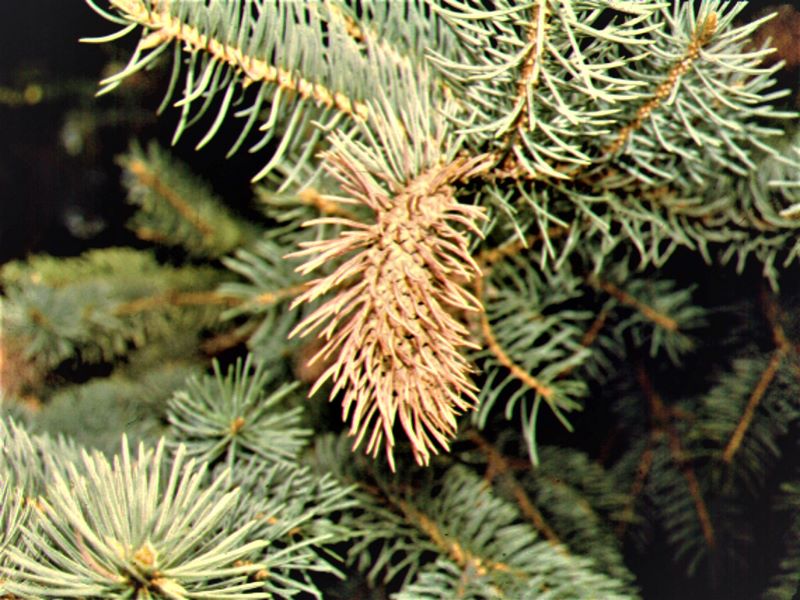
During late July or early August the adult Cooley spruce gall adelgids will emerge from the opened brown pineapple shaped galls. (Photo Credit: Steven K. Rettke, Rutgers Coop. Ext.)
Sometimes Douglas-fir is so heavily attacked that needles are spotted, bent, or distorted. Two or more generations can occur on Douglas-fir through the following season (Christmas tree growers will treat Douglas fir when new growth is 3-4 inches). By next fall another winged generation flies back to spruce and lays eggs for the cycle to repeat itself.
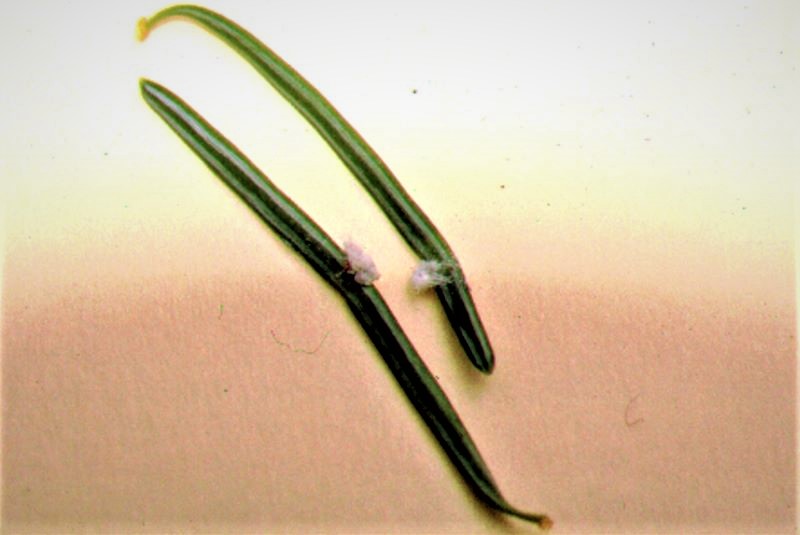
After the Cooley spruce gall adelgid winged adults emerge from the “pineapple” galls on spruce some will relocate & infest Douglas-fir needles. They will remain on this host for the remainder of the summer. (Photo Credit: Steven K. Rettke, Rutgers Coop. Ext.)
Control by pruning out galls when seen before they open in mid-summer. Place sticky traps out in summer (Douglas-fir or spruce) (1850-1950 GDD) to determine the timing to spray adults with insecticidal soap (+ sticker). In southern NJ some of the tip “pineapple” galls on spruce will soon open up, and the winged adults will emerged. Except to improve the aesthetic appearance of the trees, there is nothing to be gained by picking off the galls after they have opened. Future control windows will occur during the fall or early spring months, against the overwintering females located at the bases of terminal buds. Some possible treatments include horticultural oil, carbaryl (Sevin), insecticidal soap, or imidacloprid (Merit).
The Landscape Pest Notes for July 2023 contains only insect/mite pests & a couple of predators commonly seen during the month. Contained below are 16 additional pests or predators that appear in the order they are listed as follows: Pine needle scale, Fall webworm, Obscure scale, Pitch mass borer, Two banded Japanese weevil, Aphids, Cicada killer, Juniper webworm, Sapsucker, White pine weevil, Peach tree borer, White waxy lady beetle, Japanese beetle, Oriental beetle, Dogwood sawfly, & Plant leaf galls.
Pine Needle Scale (1290-1917 GDD = 2nd generation): This native armored scale can be found feeding on most needle-bearing conifers. Under heavy infestations (10 live scales per inch of candle shoot) needles turn yellowish, then brown with eventual dieback. From a distance, the foliage may look white to gray. The reddish, second-generation crawlers are active throughout most of July and into August and feed only on needles. The adult female covers are about 1/8 inch long and are white, oyster shell shaped.
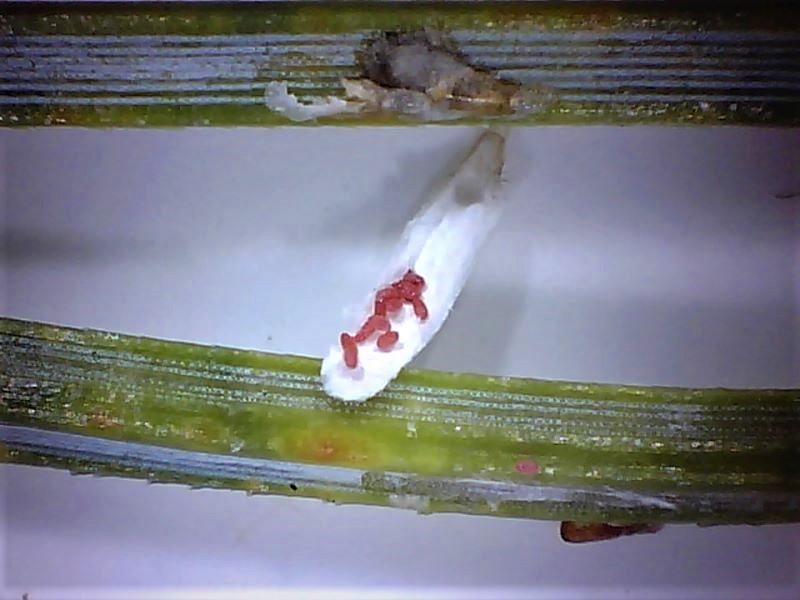
Unhatched pine needle scale eggs are visible when the female cover is turned over. Typically less than a dozen dark red colored eggs will be observed. (Photo Credit: Steven K. Rettke, Rutgers Coop. Ext.)
During July, turn over female covers and examine them with a hand lens to determine if eggs or crawlers are present. Recently hatched active crawlers are flat and reddish in color. These clumsy crawlers move precariously to new parts of the tree in search of suitable needles to feed upon. Settled crawlers then insert hair-like mouthparts into a needle to feed and develop a yellow coloration. It then immediately begins to form a new protective waxy armor. This protective cover is quite thin at first and does not thicken up until after the nymph completes its first molt (after 2 weeks). Therefore, the crawlers will continue to be highly vulnerable to sprays for a couple of weeks.
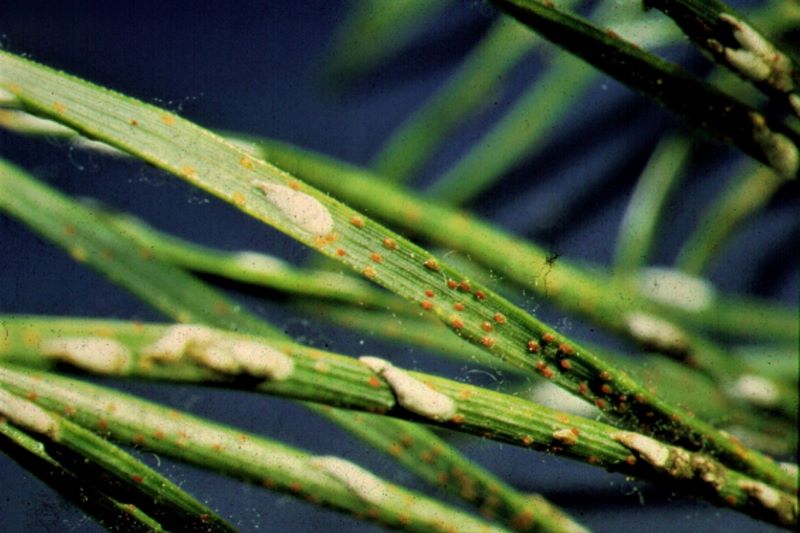
Recently hatched pine needle scale red colored crawlers are moving away from home. (Photo Credit: Ohio State Coop. Ext.)
Fall Webworm (1266-1795 GDD = 2nd generation hatch): A late-season pest of mostly visual concern. This native caterpillar feeds within silken webs encircling branches, twigs, and leaves. These caterpillars produce a web similar to the eastern tent caterpillars, except the web is at the tips of branches, and the fall webworm never leaves the protective webbing. When they need more food, the boundaries of the web are extended to include more foliage. They only feed inside the web, and they enlarge as they grow. Larvae may feed for a few weeks before webs become apparent. The webs become most obvious near the end of larvae feeding periods. The second generation is developing now. They pupate in the late summer / early fall and overwinter in the soil.
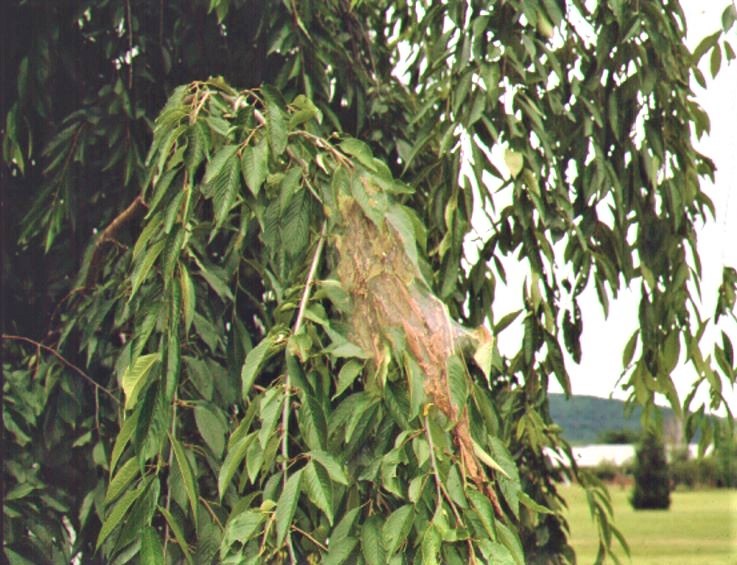
Fall webworm webbing will always be found at branch terminals. (Photo Credit: Steven K. Rettke, Rutgers Coop. Ext.)
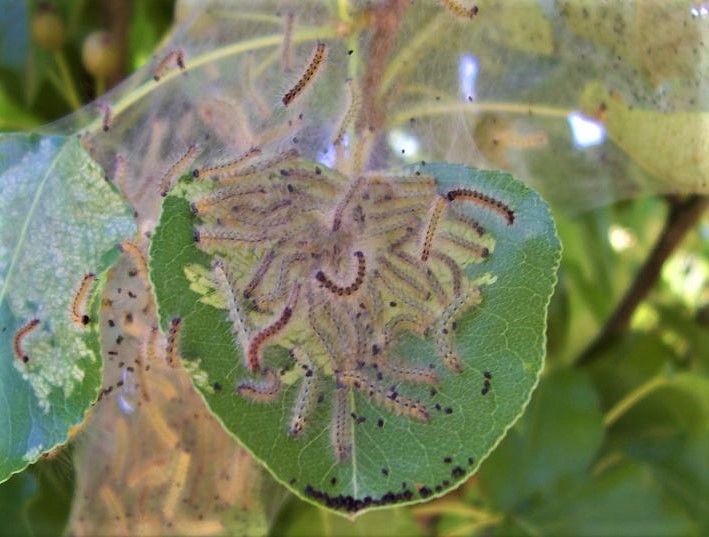
The semi-transparent webbing allows the red-headed strain of the fall webworm caterpillars to be observed. (Photo Credit: Steven K. Rettke, Rutgers Coop. Ext.)
The first generation of fall webworms in late May and June is usually relatively small, while the second generation may sometimes have outbreak populations. As a native caterpillar, many predators and parasitoids are typically available to keep populations in check. Likely, a suppressed population of some of these beneficials occasionally allows this pest to establish higher than normal population levels.
More than 100 species of trees may be attacked, including mulberry, ash, elm, linden, sweetgum, willow, walnut, hickory, oak, apple, and other fruit trees. Prune out nests (pole pruners can be useful). Unsightly webs can be pruned out or ripped open with a stick or jet stream of water, usually destroying the caterpillars. The early instars are vulnerable to sprays of Bacillus thuringiensis (B.t.), horticultural oils, and insecticidal soaps. These control materials will also have limited impacts on the many effective beneficials. Since these are true caterpillars, B.t. will control them in their early development if the application is applied now. The biorational product called Spinosad (a microbial extract) will do an excellent job of suppressing even the larger, later instar larvae. Numerous other labeled products include Scimitar, Tempo2, Sevin, and others.
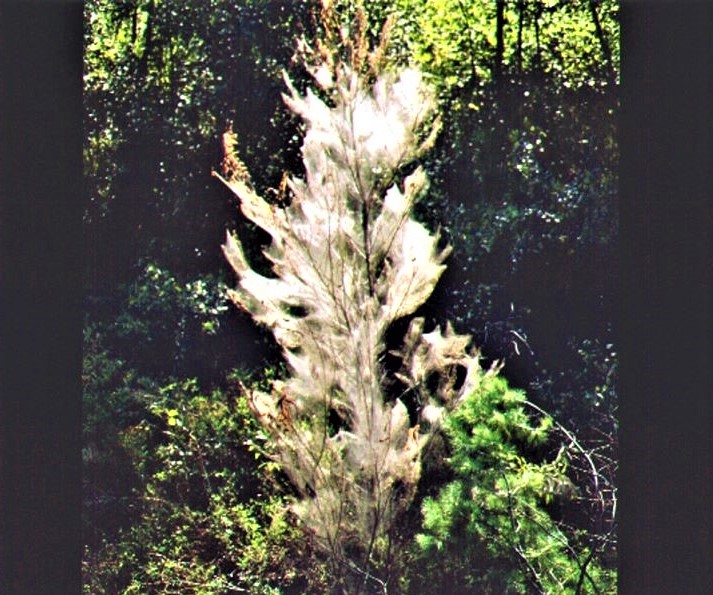
It is rare when the entire tree is enveloped by fall webworm webbing. (Photo Credit: Steven K. Rettke, Rutgers Coop. Ext.)
Obscure Scale (1500-2500 GDD = Crawlers): An armored scale that is an important landscape pest of oaks (especially pin oaks or other red oak group species). This scale should be listed as a key pest of oaks. It will also be found on dogwood, willow, chestnut, maple, hickory, and beech. As the common name of this pest implies, it is not easy to observe obscure scales. Even highly experienced arborists often do not recognize the symptoms or signs of this scale species.
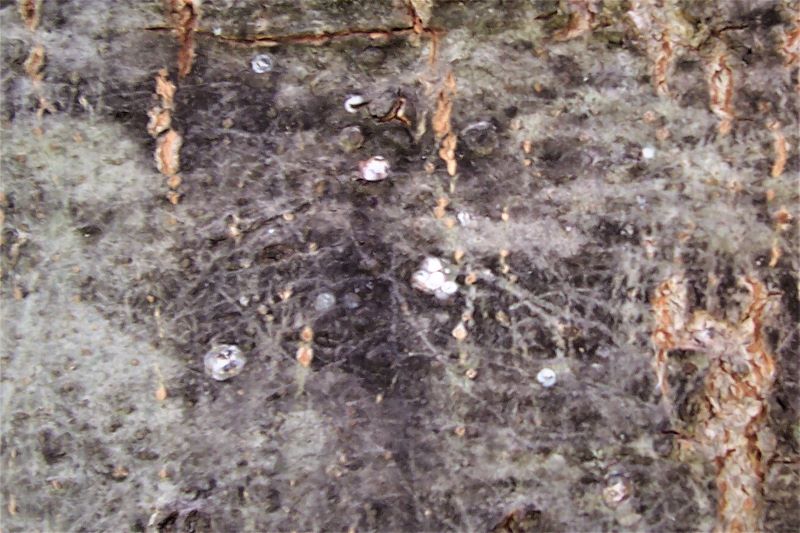
Obscure scales are easy to overlook. They have a shiny, silvery appearance & are often found clumped together. (Photo Credit: Steven K. Rettke, Rutgers Coop. Ext.)
Initially inspect 3–4-year-old wood when scouting for the presence of obscure scales. They often cause sunken areas on branches or trunks similar to cankers when grouped in large numbers. The scale covers are circular (1/10 to 1/8 inches in diameter) and its silvery gray to dirty gray coloration often blends in well on bark. This species does not feed on foliage. Although there is only one generation per year, the crawler emergence period extends for 2 months or longer. Early egg hatch begins in July, but crawlers can continue to emerge into the middle of September. The early season crawlers typically settle beneath the old, dead-scale covers to feed. The later season crawlers will usually settle within non-infested bark areas.
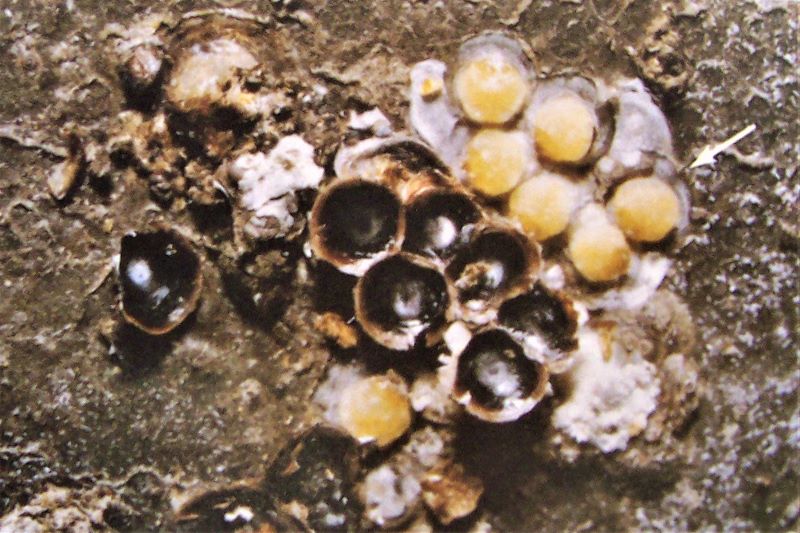
Clumped together obscure scale covers are turned over exposing the actual scale insect. (Photo Credit: Cornell University Press).
Controls: The extended crawler period, waxy cover, and settling behavior under the protection of the old, dead scale covers all complicate the control of obscure scales. They over-winter as yellow, immature nymphs. The use of dormant horticultural oils will not provide satisfactory suppression, because of the protective waxy cover. As a result, it is important to target vulnerable crawlers with insecticides during the July, August, and September months. Summer oil sprays applied to infested branches and trunks will provide good controls if adequate coverage is achieved. However, because of the long crawler emergence, multiple applications will be required (usually 2 or more sprays). To reduce applications the addition of a pyrethroid may be suggested. However, if many holes in covers are observed, this indicates beneficial parasitoid wasps. Pyrethroids are highly detrimental to parasitoids/predators and will eliminate them from the area for many weeks. Consider not using pyrethroids if beneficials are numerous.
Pitch Mass Borers and Lacbalsum Wound Dressing: Pitch Mass Borers are wood-boring caterpillars. As adults, they are called clearwing moths and are in the same family as lilac borers, rhododendron borers, peach tree borers, banded ash borers, dogwood borers, as well as others. Pitch mass borer adults are “on the wing” during the months of June and July and typically deposit eggs near wounds on several different pine and spruce species. The usual pine trees attacked include Austrian, Scotch, and eastern white. The common spruce trees attacked include Norway, white, and Colorado blue.
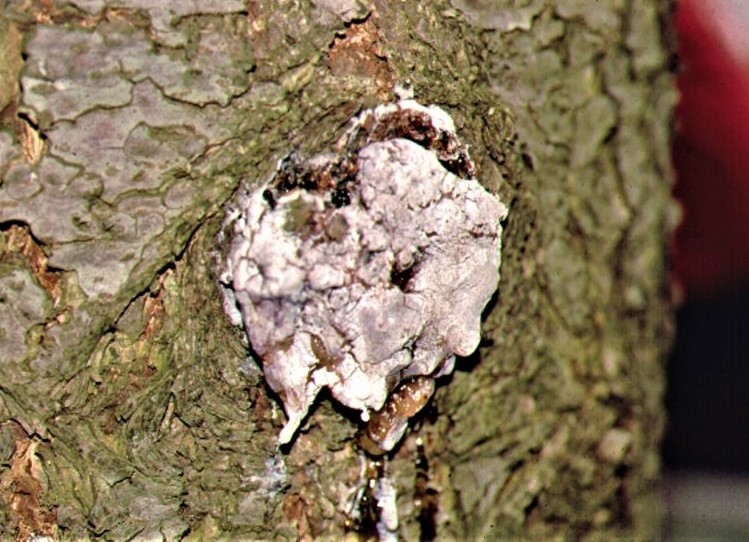
Pitch mass borer causing excess sap build up at the original pruning cut. (Photo Credit: Steven K. Rettke, Rutgers Coop. Ext.)
The pitch mass borer is primarily a nuisance in home landscapes or public park areas. Rarely do these borers create a plant health concern by girdling trunks or branches. They will take 2 to 3 years to mature and feed within the inner bark and outer sapwood. However, the shallow tunneling caterpillars do produce copious amounts of pitch. This pitch can potentially rain down on picnic tables, backyard decks, or parked cars.
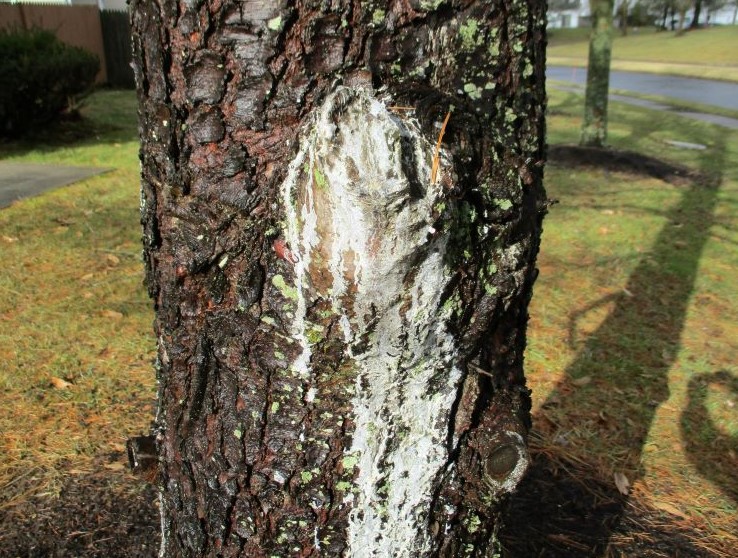
Pitch mass borers at pruning cut causing extreme sap flow down the tree trunk. (Photo Credit: Steven K. Rettke, Rutgers Coop. Ext.)
The pitch mass borer and all clearwing moths require a wound to successfully penetrate and bore into a tree. Therefore, pitch mass borer attacks will often increase after pruning wounds are made (proper pruning cuts included). Several years ago, some studies performed by Cornell University researchers unintentionally showed that pitch mass borer attacks could be reduced on recently pruned pines or spruces by applying a wound dressing. They applied a new generation wound dressing called Lacbalsum (which has a flat gray color) over the fresh pruning cuts. The conifers receiving the wound dressing showed no evidence of pitch mass borer infestations after 2 years. The Lacbalsum acted as a protective barrier and/or did not attract egg deposition. On the other hand, 30% of the conifers not receiving the wound dressing showed evidence of pitch mass borer activity one or two years later (Note: proper experimental protocol was not followed in determining these results).
The Cornell research aimed to determine the health effects on conifers after applying the new Lacbalsum wound dressing. A few decades ago, the late Dr. Alex Shigo made a strong case against the use of some tested wound dressings, demonstrating that they increased wood decay. Although the Lacbalsum wound dressing did not decrease wood decay in the pruning cut areas, the study also showed it did not increase wood decay either. Therefore, the Cornell research indicated that this new generation wound dressing could be safely used to improve the aesthetics after pruning without harming conifer trees.
Two-Banded Japanese Weevil (1644-2271 GDD = 1st adult emergence): This flightless weevil prefers shrubs such as privet, azalea, rhododendron, mountain laurel, euonymus, and many others. Adults chew notches in leaf margins similar to the black vine weevil, except the two-banded Japanese weevil typically feeds deeper toward the mid-rib. Another difference is that they feed during the day (the black vine weevil feeds at night, especially during dusk).

Two banded Japanese weevil feeding symptoms on Rhododendron leaves. (Photo Credit: Steven K. Rettke, Rutgers Coop. Ext.)
Adults are about 3/16 inch long, round, and brown to gray with two darker bands across the wing covers. Look for leaf notching damage on lower leaves beginning in late July. Control with acephate (Orthene) when the adults are actively feeding, and/or handpick or trap by laying a white sheet under the affected shrub and shaking the shrub.
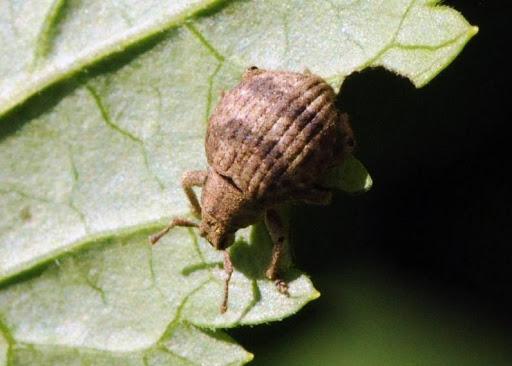
Close-up of the two banded Japanese weevil adult. (Photo Credit: Univ. of MD Coop. Ext.)
Aphids: Most of the aphid species that were present this spring on the new growth of certain plants (e.g., burning bush and spirea), have long ago moved on to feed on alternate hosts (often weeds). However, many shade trees (maples, oaks, lindens, birches, tulip poplars, etc.) still have populations of aphids. When encountered, first consider if the pest is presenting an aesthetic problem. Is the honeydew/sooty mold an eyesore on the tree or is it a nuisance, appearing on objects under the tree such as a car, patio furniture, or the house? Aphids rarely threaten the health of the tree, particularly later during the season. Action is only necessary if the customer is upset or inconvenienced by the presence of honeydew or sooty mold. If left alone, predators may maintain the population within acceptable levels.
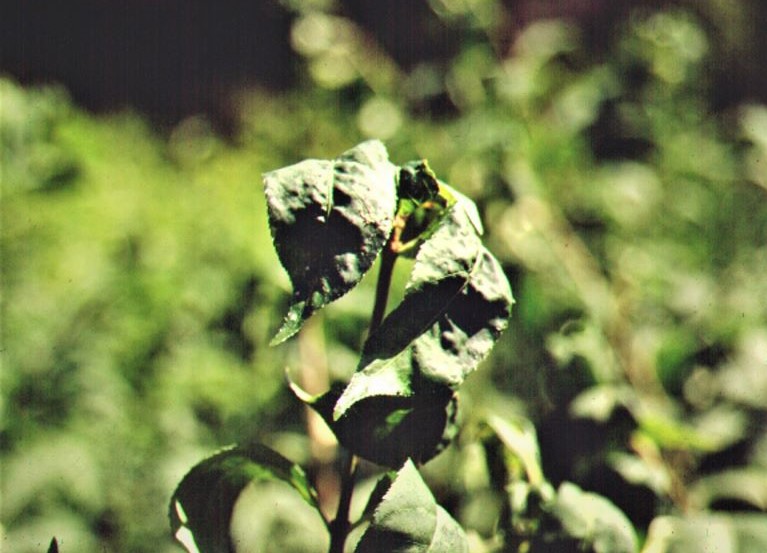
Aphids feeding during spring on burning bush. Leaf symptoms showing curling & distortion. (Photo Credit: Steven K. Rettke, Rutgers Coop. Ext.)
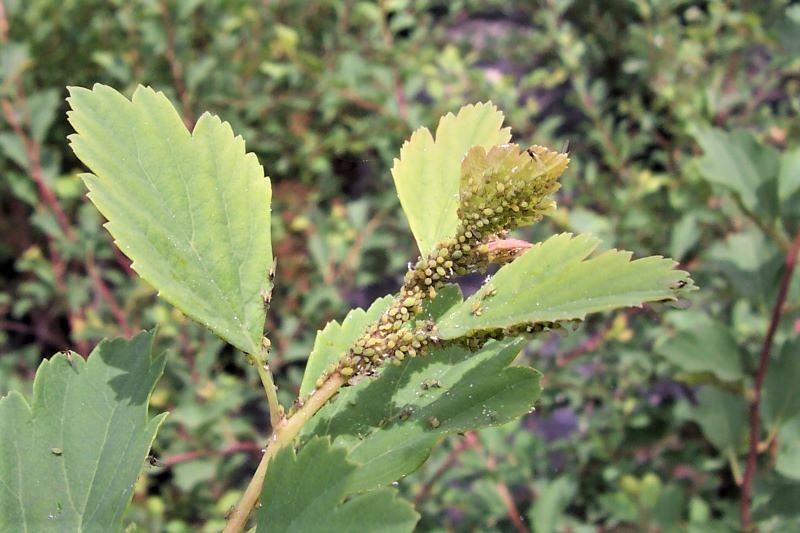
Aphids in spring infesting Spirea leaves. With both of these plants the spring feeding aphids will relocate to different hosts during the summer month. (Photo Credit: Steven K. Rettke, Rutgers Coop. Ext.)
Cicada Killers: These large, yellow, and black wasps resemble hornets & can be seen starting in late July through August & into September. Usually found nesting in the ground, the female wasps will prey on annual (“dog-day”) cicadas and drag them into their underground tunnels as food for their young. While the female searches for prey, the male wasp guards the nest. Males are aggressive but cannot sting since they do not have an ovipositor (stinger).
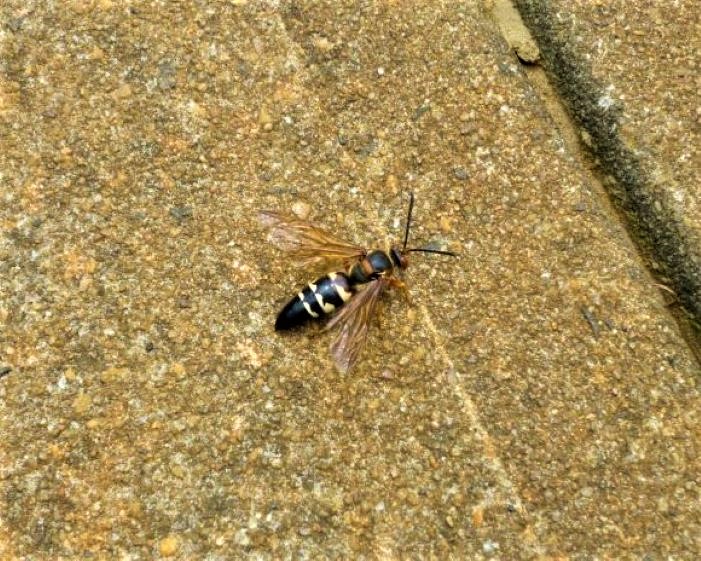
Cicada killers are excellent predators against the “dog-day” annual cicadas. Although intimidatingly large, they rarely sting people. (Photo Credit: Steven K. Rettke, Rutgers Coop. Ext.)
Tolerate these if possible. They are useful predators & help keep the populations of annual cicadas at manageable levels. Large numbers nesting in one area can be damaging to turf, particularly on banks or near access areas. When necessary, controls can be achieved by applying Sevin dust (or granules) at dusk to the entry holes.
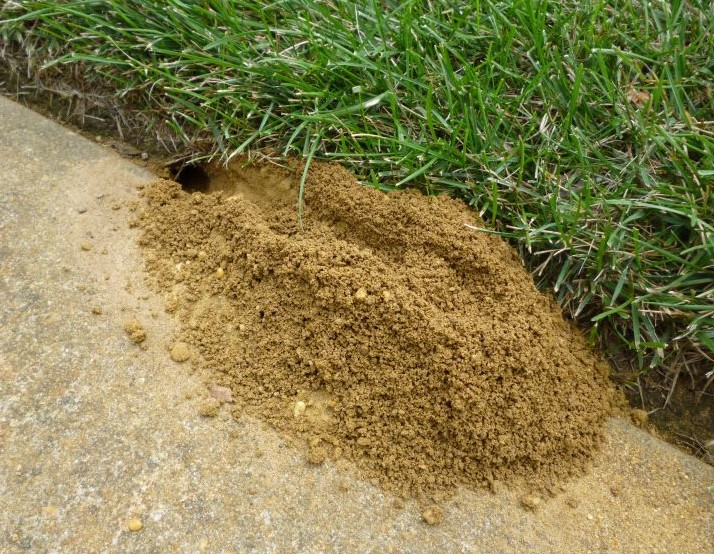
Cicada killer females will drag paralyzed annual cicadas into underground nest entrance holes. Once inside nest, the cicada killer larvae will feed on them. (Photo Credit: Steven K. Rettke, Rutgers Coop. Ext.)
Juniper Webworm (1645-1917 GDD): This web-making caterpillar spins silk to fasten together the needles & twigs of juniper. The black-headed, brown-striped caterpillar is well hidden within the webs. They will initially mine within the foliage, but then completely consume needles when larger. Symptoms first appear similar to spider mite damage since needles are yellowing, but webbed needles will brown & die. Pull apart needles, pay close attention to the densest part of the plant, & look for the silk webbing, the caterpillars, and the frass. Prune out small infestations. A translaminar spray of Orthene (acephate) will offer good control, but sprays of residual insecticides still must penetrate the dense webbing. Reduced-risk insecticides including chlorantraniliprole and spinosad are labeled for use against caterpillars.

Juniper webworm caterpillars feeding inside extensive webbing nest. (Photo Credit: UMass Coop. Ext.)
Sapsuckers: The characteristic straight rows of holes from the pecking of the yellow-belly sapsuckers are a curiosity to many. The birds are not searching for the larvae of boring insects as often erroneously assumed. Alternatively, they eat the live inner bark (phloem) of the trees as well as any insects that are attracted to the resulting wounded areas& sap flow that their pecking creates. Unless the holes are close enough together to cause girdling of stems or branches, the trees are usually not adversely affected. Once these migrating birds have identified a suitable tree, they return year after year.
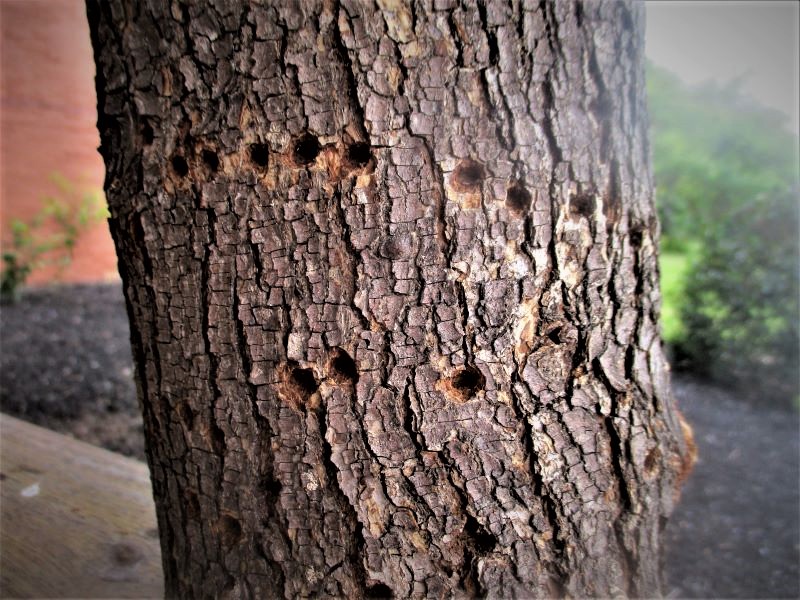
Sapsucker tree trunk injuries showing characteristic horizontal straight line feeding. (Photo Credit: Steven K. Rettke, Rutgers Coop. Ext.)
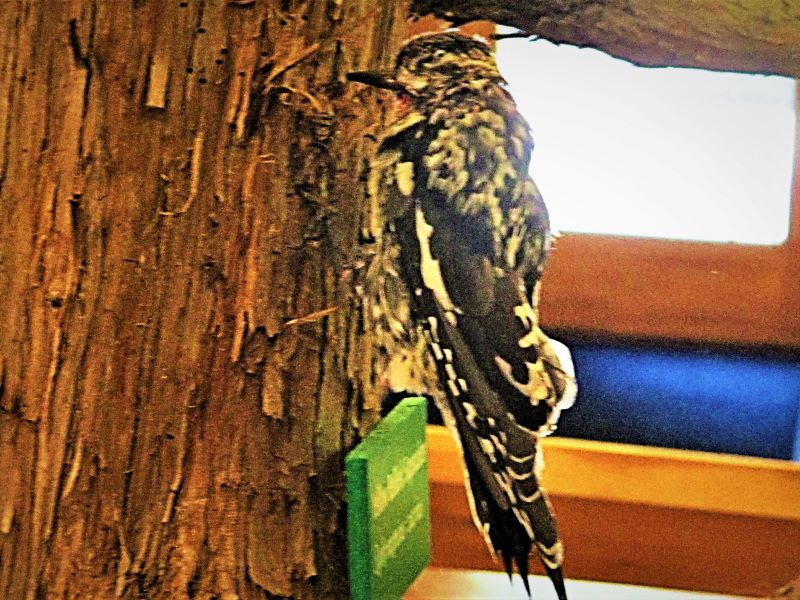
The yellow-bellied sapsucker is a migratory bird that feeds on the inner bark of certain tree species. (Photo: Stuffed bird at a nature display)
White Pine Weevil (1200-1400 GDD = 2nd generation adults emerge): Damage from these weevil larvae has been evident for the past couple of weeks in many parts of NJ on Eastern white pine, Norway & Colorado spruce, & also Douglas-fir. The larvae have been feeding within the terminal leaders since mid to late April. When the terminal is heavily infested, larvae feed side by side in a ring encircling the stem. Most of the larvae reach maturity by mid-July & pupate. Adults emerge 10 to 14 days later through small holes at the base of the infested terminal. Time is rapidly running out to remove the damaged terminal before the adults emerge (some of the earlier pupated weevils may have already emerged). Only one generation is produced per year. Adults spend the winter in the leaf litter under or near the host trees. Chemical sprays have poor efficacy against the summer emerging adults. Targeted sprays to the terminals can be effective against the feeding adults as they fly or crawl to the leaders during March & April. Most feeding by adults is done within 10 inches of the top terminal buds.

White pine weevils in “chip cocoons.” By mid-July in many areas of NJ, the white pine weevil larvae have pupated within terminal leaders. (Photo Credit: Steven K. Rettke, Rutgers Coop. Ext.)
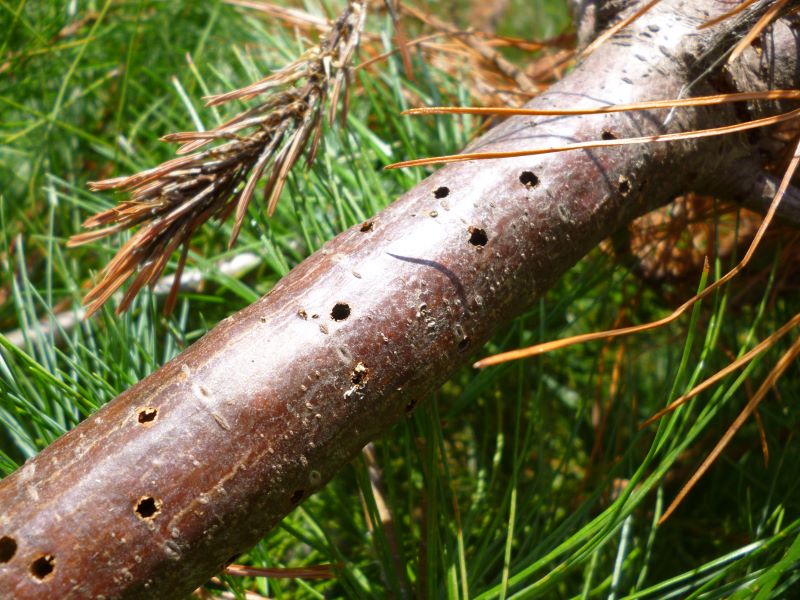
White pine weevil adult emergence holes in terminal leader. Too late to control by pruning out the leader. (Photo Credit: Steven K. Rettke, Rutgers Coop. Ext.)
Peach Tree Borer (1500-1800 GDD = larvae): The egg-laying adults have one of the longest flight periods of all the clearwing moth borers (June to September). Peach tree borers most commonly attack trees or shrubs within the genus Prunus. Japanese flowering cherry, cherry laurel, & purple-leaf sand cherry are the preferred hosts. There is one generation per year & the larvae overwinter in tunnels in wood or under bark.
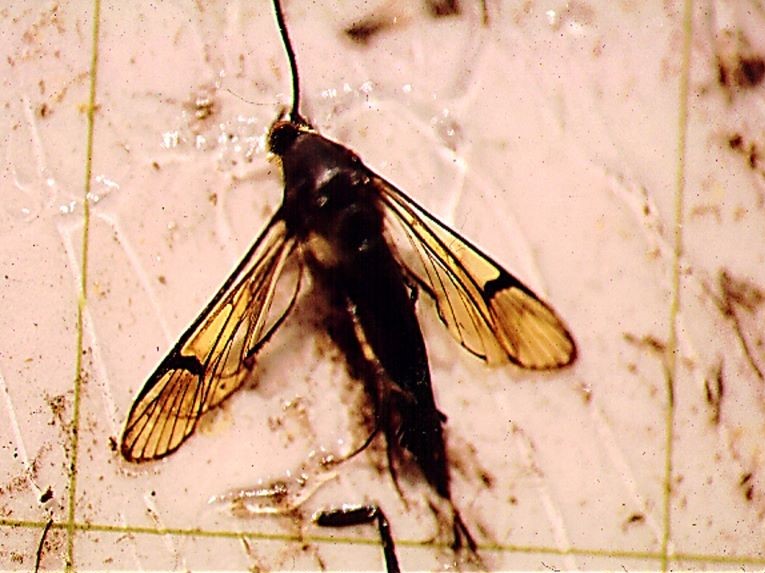
Peach tree clearwinged moth adult. This moth was captured in a pheromone trap. They resemble wasps to help avoid predators. (Photo Credit: Steven K. Rettke, Rutgers Coop. Ext.)
The relatively large larvae can reach 1.25 inches in length & will often kill smaller trees within 2 years. Larger caliper trees will typically decline more slowly, displaying symptoms such as branch dieback within the canopy & gummosis (with frass) at the root/crown area near the soil line. Inspect under the mulch that may be piled up against the trunk for signs of symptoms of borers. Look for trees with cracked bark, exit holes & pupal skins in stems along with gummosis & frass. Likewise, do not apply thick mulch against Prunus stems/trunks since this attracts egg-laying peach tree borers.
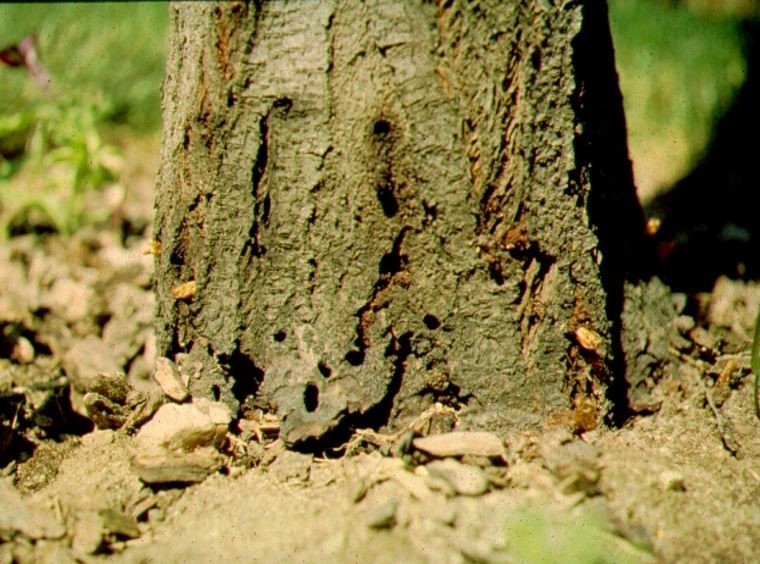
Exit holes at base of Prunus tree from adult peach tree borers. (Photo Credit: Ohio State Coop. Ext.)
Chlorantraniliprole is a reduced-risk insecticide that can be effective against clearwing borers. Pyrethroids can be applied as a preventative treatment to the root-crown & lower trunk areas of the bark. Since egg laying can occur throughout the summer, several applications may be necessary starting in June. Entomopathogenic nematodes sprayed as a curative treatment on cherry laurel have proven somewhat effective.
White Waxy Lady Beetles: Occasionally during monitoring observations, white waxy, mealybug-like creatures may be noticed. The typical response is to assume they are insect pests that require control. Do not jump to quick conclusions! Chances are good that these are beneficial lady beetles & they are providing free pest control.
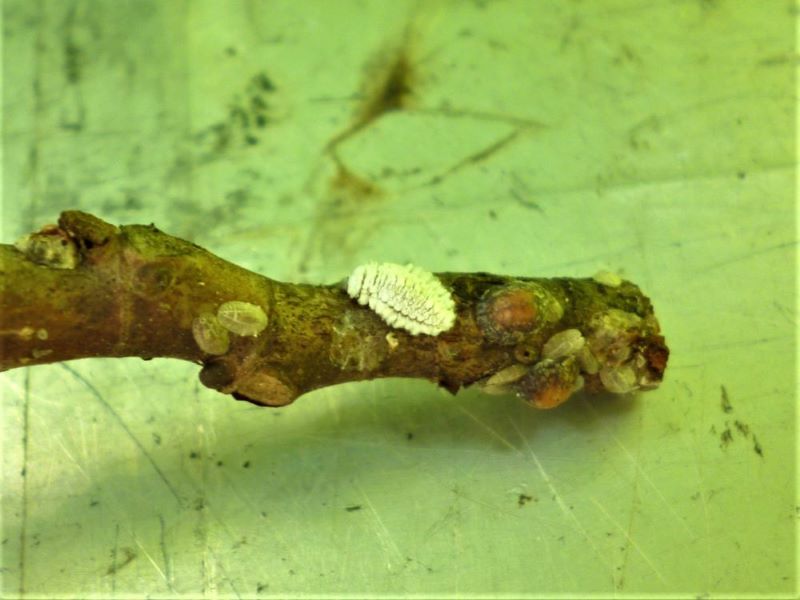
Chilocorus lady beetle larva predator. The white waxy filaments surrounding body mimics the appearance of mealybugs. (Photo Credit: Steven K. Rettke, Rutgers Coop. Ext.)
Some Chilocorus species (e.g., twice-stabbed lady beetle) larvae can occasionally form white, waxy filaments around its body, which make them less recognizable to many landscapers & nursery personnel. These “disguised” lady beetles seem to most commonly be found feeding on soft scales/eggs, such as magnolia/tulip tree scales & cottony camellia scales. If not needlessly destroyed by pesticides, they can often be seen voraciously consuming many of these “bad guys.” Learn what these disguised lady beetle larvae look like. Don’t destroy them when they are trying to help.
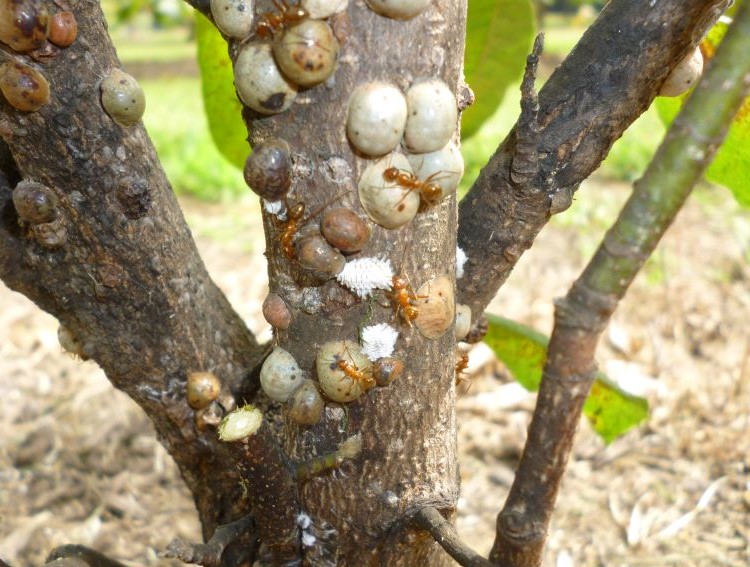
White waxy lady beetles feeding on tulip tree scales amongst ant population. The ants were not fighting off predators because of the mealybug mimicry. (Photo Credit: Steven K. Rettke, Rutgers Coop. Ext.)
Japanese Beetles (1029-2154 GDD): Adult beetle emergence is in full swing now. They will mate, then feed &lay eggs for approximately 6 weeks. Look for adults on preferred hosts from late June through early August. Research shows that Japanese beetles are especially attracted to plant-feeding damage (i.e., plants fed upon by beetles attract other beetles). This is why Japanese beetles often appear to cluster on one particular plant. In NJ, during the past couple of decades, this scarab beetle pest has not been nearly as prominent as it once was. The Oriental beetle has replaced it as the #1 scarab beetle pest species in our area.
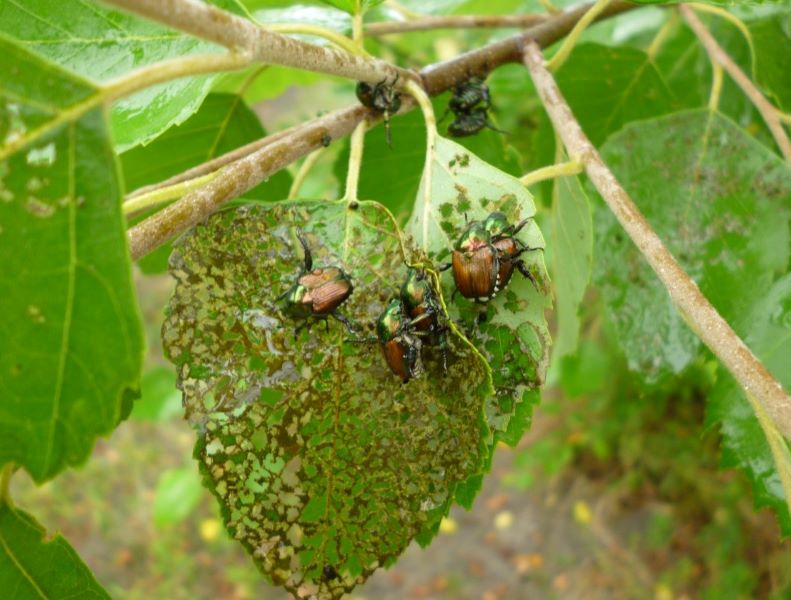
Japanese beetle adults skeletonizing leaves. Plant feeding damage will often attract additional Japanese beetles. (Photo Credit: Steven K. Rettke, Rutgers Coop. Ext.)
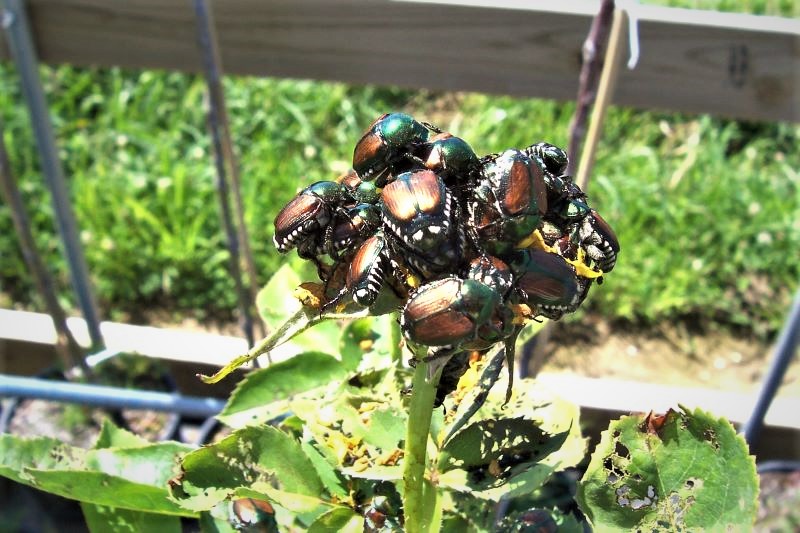
Japanese beetle mating swam. Another powerful attractant that brings the beetles together. (Photo Credit: Steven K. Rettke, Rutgers Coop. Ext.)
The use of standard pesticide controls against Japanese beetles has included Sevin (carbaryl), Orthene (acephate), & various pyrethroids have been shown to give excellent knockdown. Watch for spider mite outbreaks to follow when using Sevin or some of the pyrethroids (e.g., Tempo). A couple of reduced-risk insecticides include acetamiprid & chlorantraniliprole. Neem oil has shown a good repellency action on adult Japanese beetles. On cool/rainy days or early in the morning, adults are sluggish & can be handpicked or knocked onto a drop cloth.
Oriental Beetles (1147 GDD = adult emergence): This scarab beetle feeds as an adult on grass blades & flowers (dahlia, hollyhock, phlox, & rose) but does not cause significant damage. Adults are oval & straw-colored with black markings & are slightly smaller than Japanese beetles. Similar to Japanese beetles, adults emerge from the soil in late June (Oriental beetles may be a week earlier) & continue to emerge through August. The damaging larval (grub) stage feeds not only on turf roots (especially turf adjacent to ornamentals) but also ornamentals & nursery stock roots & plant crowns. Root damage to especially ericaceous container plants is significant in some NJ nurseries.
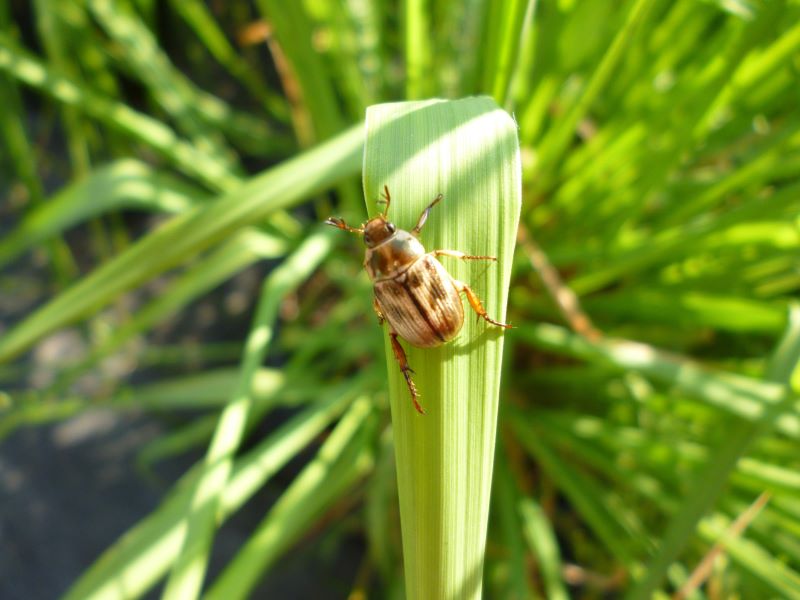
Oriental beetle adult male searching the air to detect female pheromones. (Photo Credit: Steven K. Rettke, Rutgers Coop. Ext.)
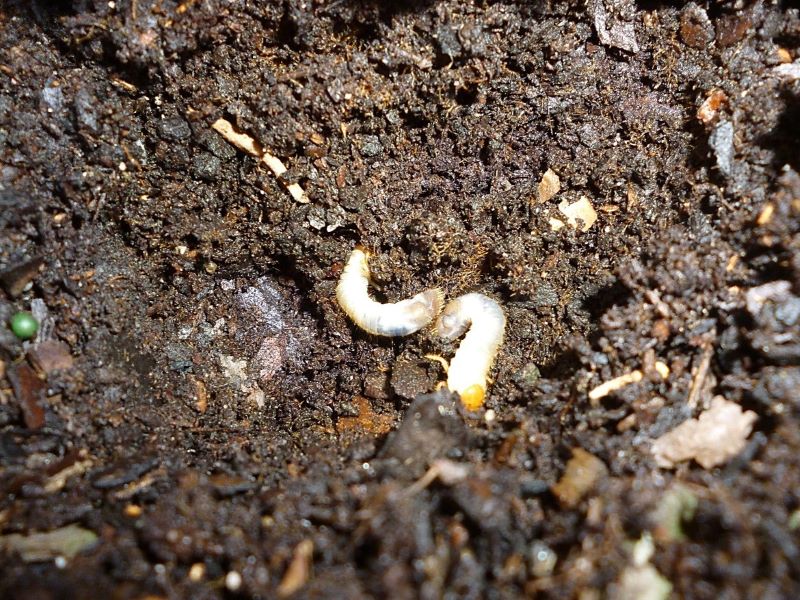
Oriental beetle grubs feeding on roots within nursery containers. (Photo Credit: Steven K. Rettke, Rutgers Coop. Ext.)
A mixture of grub species is often found together in soil populations with other grub species. To identify specific species, look at the pattern of spines on the underside of the abdomen (raster pattern). Two straight parallel rows of spines will identify the Oriental beetle, while a “V-shaped” raster pattern identifies the Japanese beetle. Within nurseries, when a history of damage indicates populations of Oriental beetle grubs have become established in the area, then preventative insecticide applications in the containers are warranted. The use of systemic imidacloprid will provide summer-long control within containers. Also, the use of Oriental beetle mating disruption pheromones placed in nurseries has been used successfully for the past 6+ years.
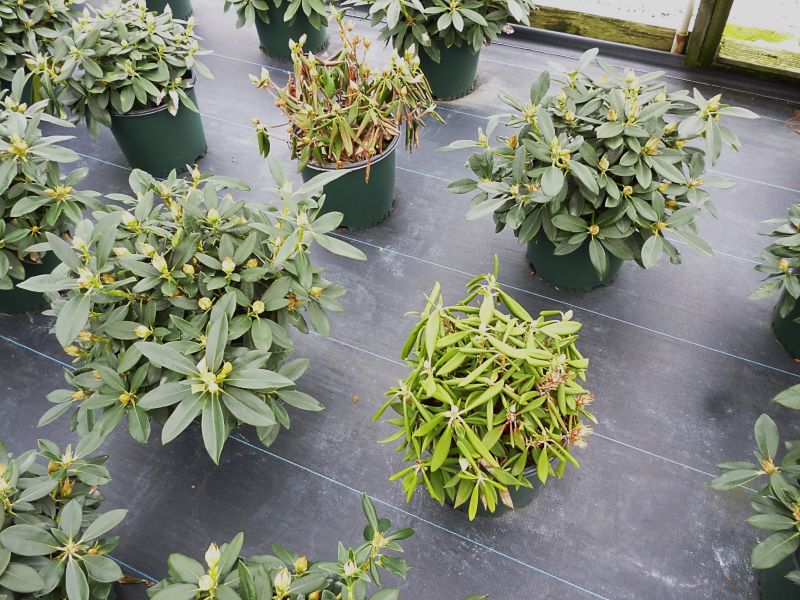
Oriental beetle grub damage to Rhododendron container plants. Adult females are often attracted to Rhododendron to lay eggs. (Photo Credit: Steven K. Rettke, Rutgers Coop. Ext.)
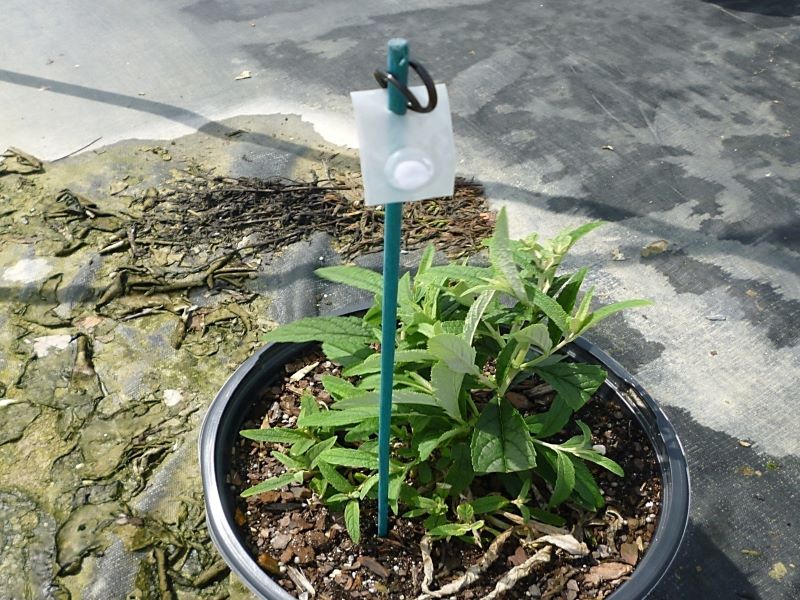
Oriental beetle pheromone mating disruption lure. Have been used within nurseries the past several years to control this grub feeding pest. (Photo Credit: Steven K. Rettke, Rutgers Coop. Ext.)
Dogwood Sawfly (1151-1500 GDD): The larvae of this non-stinging wasp may sometimes cause severe defoliation to many varieties of Cornus species. The larvae & their shed skins can resemble bird droppings. They also superficially resemble caterpillars but since they have 6 prolegs they are correctly classified as sawflies. Young sawflies will initially skeletonize leaves. Larger larvae consume the entire leaf area except for the mid-veins. They feed in groups along the margins of leaves.
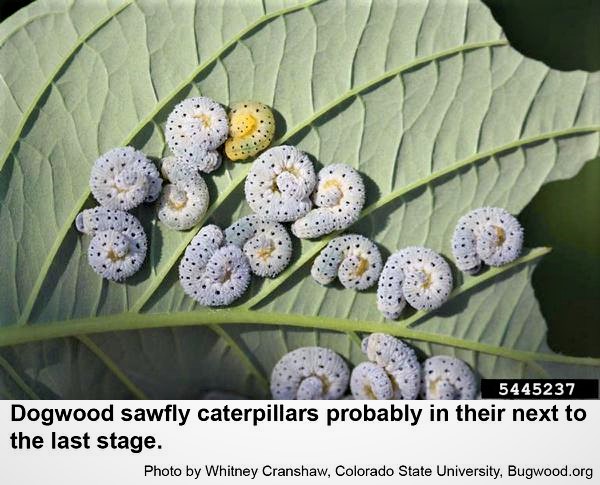
Dogwood sawfly penultimate caterpillar. (Photo Credit: Whitney Cranshaw, Colorado State Univ.)
The larvae have the curious ability to change appearance greatly as they develop throughout the instar stages. First instar dogwood sawfly larvae resemble small, greenish-yellow tadpoles. Second & third instar larvae have a smooth, amber-colored body with black rectangular markings along the top & sides. Maturing larvae have a white powdery coating over the surface of their bodies. The final instar larvae eventually stop feeding in groups & disperse throughout the tree to feed individually.
Controls: Dogwood sawflies can be easily pruned-out or handpicked when within reach & they are still young & feeding within groups. Soaps & oils may provide effective controls if small larvae are directly contacted. Translaminar materials such as Orthene (acephate) & numerous contact materials (pyrethroids) will destroy populations. Parasitoids & predators are generally not reliable for suppression.
Plant Galls: Plant galls often attract considerable curiosity because of their unusual shapes & colors. Galls are considered to be abnormal growths developing in plant tissue due to the introduction of a foreign substance. A gall is made up of plant cells that have been stimulated to undergo rapid division & growth by the presence of foreign substances. Many gall producers are caused by tiny wasps, midges, & mites. Other gall inducers can be from aphids, psyllids, flies, & adelgids. Some galls are produced by fungi, nematodes, bacteria, viruses, & by mechanical injury.
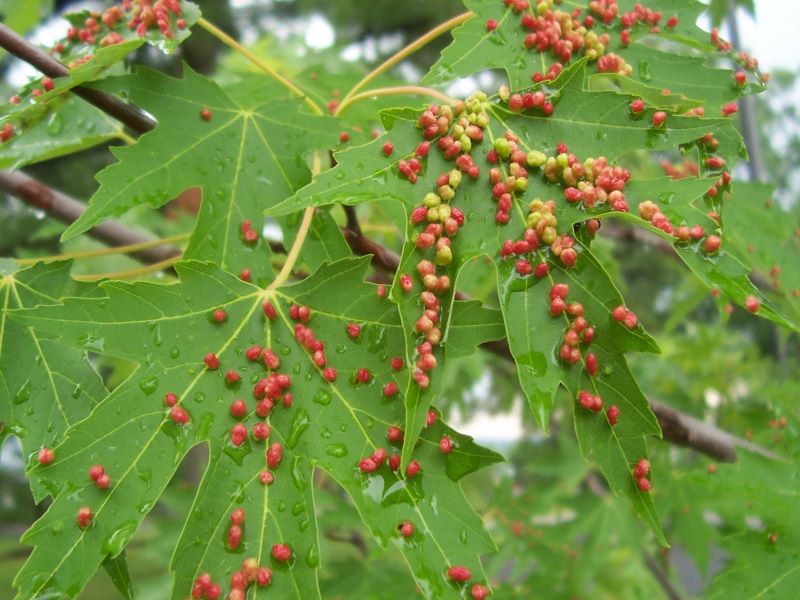
Maple bladder galls are caused from eriophyid mites. (Photo Credit: Steven K. Rettke, Rutgers Coop. Ext.)
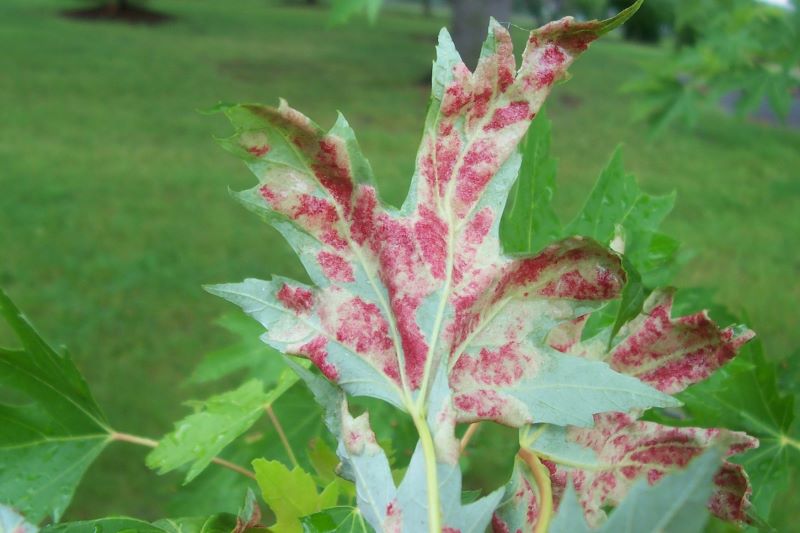
Maple Erinium galls are also caused by eriophyid mites. (Photo Credit: Rutgers Coop. Ext.)
Many galls will form on susceptible plants when an insect deposits eggs in rapidly growing plant parts. Chemical fluids may be deposited simultaneously with eggs which stimulate tissues to grow over the eggs. Upon hatching, the protected larvae feed internally on the gall tissue until they complete their life cycles. At one time, the fantastic cellular growth of these galls had been of interest to scientists conducting cancer research. Most leaf gall types only cause cosmetic damage to ornamental plants & therefore control measures are not needed. Proper control timings is also difficult to successfully achieve.

